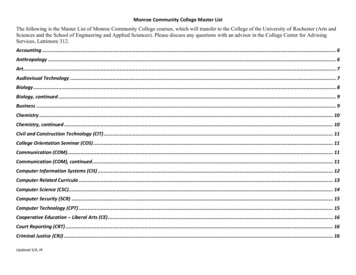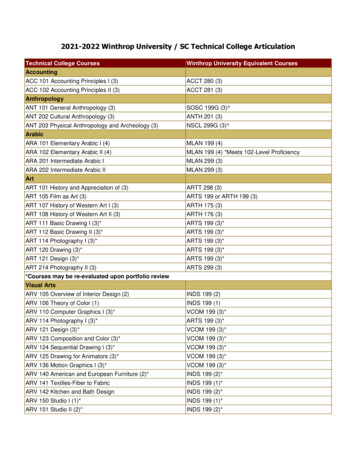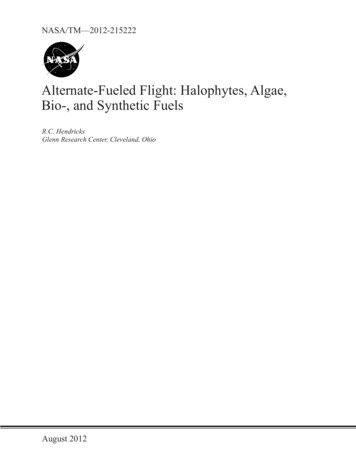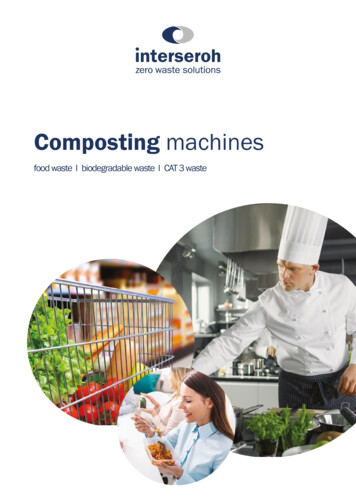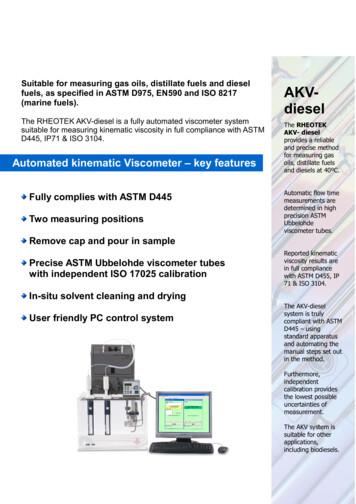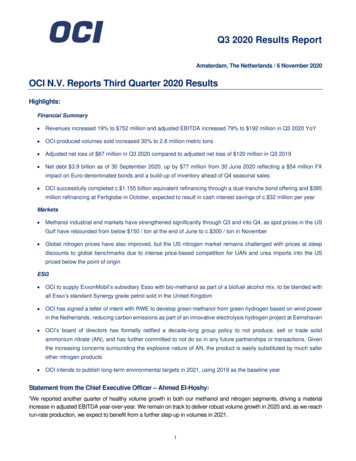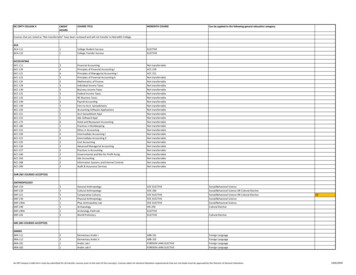
Transcription
International Journal of Research Studies in Biosciences (IJRSB)Volume 2, Issue 1, February 2014, PP 1-5www.arcjournals.orgProduction of Bio Fuels from Eichhornia Crassipes AlgaeMrs. Thamari SengudzwaHarare Institute of TechnologyBelvedere, Hararetsengudzwa@hit.ac.zwMr. Ngoni Chirinda, Ms Mercy Manyuchi, Mr. Cephas Mawerengoniex@yahoo.com.au, mmanyuchi@hit.ac.zw, cmawere@hit.ac.zwAbstract: In a bid to promote renewable energy and control of dam pollution, algae, a plant notorious forgrowing in waste water dams was used to produce algae oil. Algae plantswere collected from the dam andalgae oil was extracted using the Soxhlet procedure. Hexane was used as the solvent. A conversion rate of14% was obtained for an extraction time of 6 hrs. This algae oil will then be trans-esterified to produce abio fuel. The bio fuel can be used as an alternative to petrochemical fuel and is sulfur free. Moreover, it isproven to be the cleanest fuel for combustion systems.Keywords: Algae Oil, Bio Fuels, Renewable Energy, Soxhlet Extraction1. INTRODUCTIONThe production of biodiesel using algae biomass has received much attention throughout theworld. This is due to depletion of fossil fuels and also due to the accumulation of greenhousegases in the environment. The use of renewable and carbon neutral biodiesel from algae isnecessary for a sustainable environment. Much attention is being directed to finding alternativeenergy resources for many countries. According to Korbitz (1999) the energy crisis in the worldhas led many countries to take a series of steps to resolve this problem [1]. The increasing need offuel in Zimbabwe in transport industry and agricultural sector has necessitated the search for otherfuels as an alternative to diesel. Therefore, alternative biodiesel is the only option to fulfill therequirements in future.1.1 Eichhornia Crassipes AlgaeEichhornia crassipes algae is a cosmopolitan, perennial, mat-forming aquatic species, which cantolerate a wide range of habitat conditions (temperature, illumination, pH, salinity, winds, currentand drought. It is primarily a fresh water plant but can survive up to 13 days in sea water. Optimalgrowth conditions are a pH of 7.0, a phosphorus concentration of 20ppm and adequate nitrogen.The largest infestations are thus found in waters enriched by sewage and industrial effluent or byrun-off from fertilized agricultural land. The algae is morphologically very plastic with rapidvegetative propagation, features that make it well adapted for long distance dispersal andsuccessful colonization of diverse habitats.Fig1. Eichhornia crassipes algae2. BRIEF LITERATURECurrently, bio-ethanol from corn starch, sugar cane or sugar beet, and biodiesel from oil cropssuch as palm and oilseed rape, is the most widely available forms of biofuel. However, ARCPage 1
Mrs. Thamari Sengudzwa et al.sustainability of these biofuels is an issue since production of a significant proportion of fuelresult in competition for arable land with food crops[2]; [3]. The use of algae overcome thisconcern since algae has higher productivities than land plants, with some species having doublingtimes of a few hours, some species can accumulate very large amounts of triacylglycerides(TAGs), the major feedstock for biodiesel production and high quality agricultural land is notrequired to grow the biomass.The use of algae for biofuels production can also serve otherpurposes. Some possibilities include the removal of CO2 from industrial flue gases by algae biofixation [4] , reduction of green house gas emissions of a company while producing biodiesel,wastewater treatment by removal of NH4 , NO3 , PO4 ions, making algae to grow using thesewater contaminants as nutrients or ponds [4] . After algae oil extraction the resulting algaebiomass can be processed into ethanol, methane, livestock feed, used as organic fertilizer due toits high N:P ratio, or simply burned for energy cogeneration [4]. The ability of algae to growunder harsher conditions with reduced nutrient requirements means it can be grown in areasunsuitable for agricultural purposes independently of the seasonal weather changes, thus notcompeting for arable land use, and can use wastewaters as the culture medium, not requiring theuse of freshwater.There are three well-known methods to extracting the oil from microalgae namely: (1)Expeller/press method, (2) Solvent extraction using chemicals method and (3) Supercritical fluidextraction method [5]. The most popular extraction method is the Soxhlet extraction using hexaneas a solvent and an extraction time of 4 hours[6]. Other solvents, such as petroleum ether,methanol or a hexane–ethanol mixture, can be used. There are many factors to be considered andoptimized in production and extraction of algae oil from algae. These include energy and materialinputs such as nutrients, and energy for mixing during growth, and appropriate treatment of wasteproducts and varying some factors on the extraction process itself.The objectives of this studywere therefore to find optimum operating conditions for the extraction of algae oil using Soxhletextraction method. The ratio of algae to the amount of hexane used was varied from that inliterature and extraction time was ranged from four to six hours. Other solvents such as methanoland ethanol will be examined in the future.3. MATERIALS AND METHODS3.1 MaterialsAlgae plants were obtained from Lake Chivero where they are rapidly multiplying daily becauseof waste water. Thealgae were dried and then crushed using a multifunction blender (Home luckP505). It was ensured an average moisture content of 14.36% and was achieved @180ºC for 5minutes. A moisture analyzer model MS-70 (A and D Company Ltd) was used for moistureanalysis. 4g of the crushed algae was then used in the algae oil extraction. The mass of the driedalgae was measured using an electronic precision balance model BNI-E510.n-hexane with 99.5% purity was used as the extracting solvent. The hexane was obtained fromAssociated Chemicals Enterprises (ACE) Pvt Ltd.3.2 Extraction methodThe Soxhlet Extraction method/Hexane solvent oil extractionThe Soxhlet Extraction method/Hexane solvent oil extraction was used with minor modification.The extraction time range employed was 4 to 6 hours. This procedure can also be applied atindustrial level.The Soxhlet Apparatusmodel used had a vertical condenser and it was obtained from LabConco.Solvent Extraction is a process which involves extracting oil from oil-bearing materials bytreating it with a low boiler solvent as opposed to extracting the oils by mechanical pressingmethods (such as expellers, hydraulic presses, etc.) The solvent extraction method recovers almostall the oils and leaves behind only 0.5% to 0.7% residual oil in the raw material unlike in the caseof mechanical pressing whereby the residual oil left in the oil cake may be anywhere from 6% to14%[7]. The solvent extraction method can be applied directly to any low oil content rawmaterials. It can also be used to extract pre-pressed oil cakes obtained from high oil contentmaterials. Since high percentage of oilis recovered, solvent extraction has become the mostpopular method of extraction of oils and fats[7].International Journal of Research Studies in Biosciences (IJRSB)Page 2
Production of Bio Fuels from Eichhornia Crassipes AlgaeIn a nutshell, the extraction process consists of treating the raw material with hexaneor andrecovering the oil by distillation of the resulting solution of oil in hexane called miscella.Evaporation and condensation from the distillation of miscella recovers the hexane absorbed inthe material. The hexane thus recovered is reused for extraction. The low boiling point of hexane(69 C), [7] and the high solubility of oils and fats in it are the properties exploited in the solventextraction process.3.3 Procedure4g dry sample of ground algae were putinto a filter paperbag. The filter paper bag was thenthread-tied on the open end and placed in an extraction chamber. The extraction chamber wassuspended above a round bottomed flask containing the specific hexane solvent directly below acondenser. The flask was heated and the hexane evaporated at its boiling point which is 69oC. Thehexane then moved into the condenser where it was converted into a liquid that trickles into theextraction chamber containing the algae sample. The extraction chamber was designed so thatwhen the solvent surrounding the sample exceeds a certain level, it overflows and trickles backdown into the boiling flask.At the end of the extraction process, the filter paper containing algae sample was removed. Thehexane solvent was evaporated and condensed to be recovered in another funnel for reuse insubsequent extractions. The mass of the remaining lipid was measured and the percentage of lipidin the initial sample was calculated. The experiments were carried out at different extraction timesand different amount of hexane where employed. An experimental design was used to study theeffects of these parameters on the amount of algae oil produced.The % of algae oil extracted was calculated as indicated below:* 100%3.4 Experimental DesignA 22 full factorial design wasused[8]. This was done so as to investigate the effect of extractiontime in hours and amount of hexane used in mls on the amount of algae oil extracted. Theextraction time investigated was between 4hrs and 6hrs, whereas the amount of hexane used wasvaried between 200mls and 300mls. In total 4 experiments were carried out according to thedesign as illustrated in Table 1.Table 1:22. Experimental design used to investigate effect of extraction time and amount of hexane usedExperiment1234Conditions4hrs; 200mls4hrs;300mls6hrs;200mls6hrs;300mls4. RESULTS AND DISCUSSIONThe results obtained from the experiments are shown in Table 2 and Figure 1.Table 2. Algae oil extracted (%) at varying extraction times and amounts of hexaneExtraction time(hrs)4466Amountofhexane used (mls)200300200300Amount of hexanerecovered (mls)150250100200Algae oil obtained(g)0.930.591.460.77% Algaeextracted23.2514.7536.5019.25oilIncrease in extraction timealso increased the percentage of algae oil extracted irrespective of theamount of solvent used (see Figure 1). The percentage of algae oil extracted increased by 57%when the extraction time was increased from 4hrs to 6hrs whilst a constant 200mls of hexane wasbeing used (see Table 2). Also, the percentage of algae oil extracted increased by 30.5% when theextraction time was increased from 4hrs to 6hrs whilst a constant 300mls of hexane was beingused (see Table 2). This behavior is probably because all the algae oil were extracted due to theInternational Journal of Research Studies in Biosciences (IJRSB)Page 3
Mrs. Thamari Sengudzwa et al.Algae oil extracted (%)longer times employed, even the microscopic algae oil. Also probably all the interstitial water inthe algae cell walls was taken out during the extraction process [7] . The same result of increasedalgae oil extraction rate with increased extraction time was observed by Ahmad et al., (2010)when they investigated the effect of extraction time on extraction of Herba Leonuri using theSoxhlet Procedure.403530252015102200mls of hexane345300mls of hexane678Figure 1. Effect of extraction time and amount of hexane used on algae oil extractionOn the other hand, increase in the amount of hexane used decreased the percentage of algae oilextracted (see Figure 1). The percentage of algae oil extracted decreased by 36.6% when theamount of hexane used was increased from 200mls to 300mls at a constant extraction time of 4hrs(see Table 2). Also, the percentage of algae oil extracted decreased by 47.3% when the amount ofhexane used was increased from 200mls to 300mls at a constant extraction time of 6hrs (see Table2). Ahmad et al., (2010) also reported a lack of consistence in using hexane as a solvent in theSoxhlet procedure when they investigated the mass yield obtained from hexane and methanolduring extraction of Herba Leonuri. They observed a dip in the mass yield with hexane but noconclusive result on this behavior was given.5. CONCLUSIONSThe highest yield of algae oil (36.5%) was found at an extraction time of 6hrs with 200mls ofhexane being used. This indicates that highest yields of algae are obtained with increasedextraction time and lower algae-hexane ratios.So, for production of 1000 liters of algae oil at anextraction time of 6 hours, about 2.75 tones of dry algae will be used. 140L of hexane will beemployed as solvent of which 50% of it will be recovered in the process.There is on-going work on the behavior of oil extracted with increased amounts of hexane used.In our future work, the algae oil extracted will be analyzed to determine the actual composition.Furthermore, the extracted algae oil will be trans-esterified to obtain the bio fuel.6. DELIMITATIONSThe algae oil results shown were done at micro-scale. Thus, the results projected may not be truereflections of a macro plant.7. FUTURE WORKComparative analysis of algae oil extracted from other internationally available algae species willbe done. The researcher wishesto engage the Harare City Council, Fale Treatment plant to usetheir wastewater for algae farming. In addition to this, an industrial plant for processing of the biofuels from algae at macro level will be developed and lastly commission the industrial plant.ACKNOWLEDGEMENTSThe authors wish to express their gratitude to the HIT Biotechnology, Chemical and ProcessSystems Engineering Departments technical staff for their assistance in the laboratory. Arab MoiUniversity Professor Kiriamiti is also honored for initiating the project and deciding the formationof a research consortium between Arab Moi (Eldoret of Kenya), Harare Institute of Technology(Harare of Zimbabawe) and Nelson Mandela African Institute of Science, Innovation &Technology (Arusha of Tanzania).International Journal of Research Studies in Biosciences (IJRSB)Page 4
Production of Bio Fuels from Eichhornia Crassipes AlgaeREFERENCES[1] Ryan, L., Convery, F. and Ferreira. S, “Stimulating the use of bio fuels in the EuropeanUnion: Implications for climate change policy”, Energy Policy, 2006, 34: 3184–3194.[2] Hill, J., Nelson, E., Tilman, D., Polasky, S. and Tiffany, D, “Environmental economic andenergetic costs and benefits of biodiesel and ethanol bio fuels”, Proc Natl Acad Sci U S A03, 2006: 11206-11210.[3] Stephenson, A.L., Dennis, J.S and Scott, S.A, “Improving the sustainability of the productionof biodiesel from oilseed rape in the UK”, Chem Eng Res Des, 2008, 86: p 427-440.[4] Wang, B., Li, Y., Wu, N and Lan, C.Q, “CO2 bio-mitigation using microalgae”, AppliedMicrobiology and Biotechnology, 2008, 79(5):707–18.[5] Demirbas, A, “Production of biodiesel from algae oils”, Energy Sources, 2009, A (31) : 163–168.[6] Govindarajan, L., Nitin, R. and Ahmed, A, “Novel solvent extraction for extraction of oilfrom algae biomass grown in desalination reject stream”, Journal of Algal BiomassUtilization, 2009 1(1): 18-28.[7] www.oilgae.com/algae/oil/extract/extract.html[8] Lazic, Z.L., “Design of experiments in Chemical Engineering”, 2004: 157-191.[9] Ahmad, A., Alkarhi, A.F., Hena, S., Siddique, B.M and Dur, K.W, “Optimization of SoxhletExtraction of Herba Leonuri Using Factorial Design of Experiment”, International Journal ofChemistry, 2010, 2(1): 198- 205.[10] Korbitz, W.,“Biodiesel production in Europe and North America an encouraging prospect”,RenewableEnergy, 1999, 16: 1078–83.[11] ChikwenhereG.P, Phiri G, 2010. History of water hyacinth and itscontrol efforts on LakeChivero in Zimbabwe.[12] Schenk P, Thomas-Hall S, Stephens E, Marx U, Mussgnug J, Posten C, et al. Secondgeneration biofuels: high-efficiency microalgae for biodiesel production. BioEnergy Res2008;1(1):20–43.International Journal of Research Studies in Biosciences (IJRSB)Page 5
The production of biodiesel using algae biomass has received much attention throughout the world. This is due to depletion of fossil fuels and also due to the accumulation of greenhouse gases in the environment. The use of renewable and carbon neutral biodiesel from algae is necessary for a sustainable environment.
